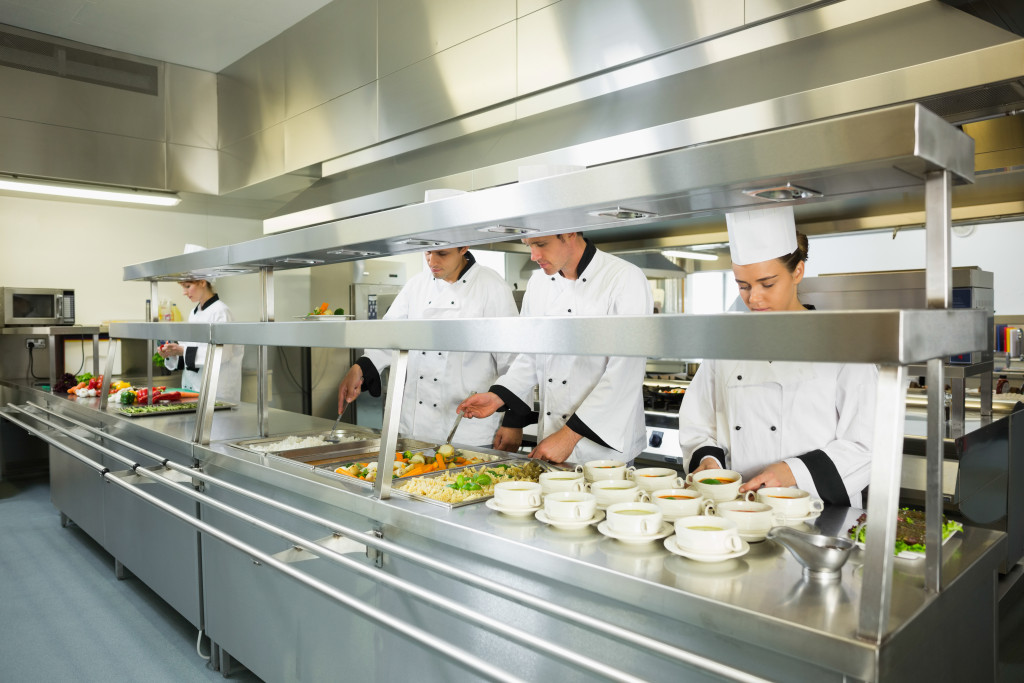• Develop an organizational system that labels both food items and kitchen equipment.
• Designate areas for specific tasks to prevent crowding in the kitchen.
• Streamline food preparation by pre-washing vegetables and eliminating unnecessary ingredients from popular menu items.
• Utilize automation tools, such as inventory management systems and innovative kitchen equipment, to help streamline processes.
A restaurant is fast-paced, and efficient operations are critical for success. From dealing with customer complaints and managing staff to food prep and inventory, many moving parts go into running a successful restaurant. One area where you can improve your efficiency is the kitchen—with some simple changes, you can increase productivity without sacrificing quality or service.
Organization and Communication
The first step in creating an efficient kitchen is ensuring everything has its place. An organized kitchen will save time when prepping meals for customers because chefs will know exactly where everything is located. Additionally, having a clear organizational system will make it easier for everyone in the kitchen to communicate with each other—which means orders can be filled faster and more accurately. Here are ways to ensure an organized kitchen:
Labeling
This goes for both food items and equipment. All food should be stored in clearly labeled containers, and kitchen equipment should have labels to indicate what it is and how it’s used. This is especially important if you have new staff members who need to be trained and new equipment to learn how to use.
Mark Areas for Specific Tasks
This will help keep the kitchen from becoming cluttered and overly crowded. For instance, designate an area for prepping meals, another for washing dishes and utensils, etc. This will ensure that everyone knows what tasks they should be doing in a certain area at any given time. This will also prevent people from crowding each other, which can lead to delays in getting meals out to customers.
Staff Scheduling
Having a clear system for scheduling staff is essential for an efficient kitchen. For example, when preparing meals in the evenings, you may want to have a few experienced chefs on hand to manage things and teach the new hires; during busier lunch periods, having additional hands on deck will ensure that orders are filled quickly efficiently.
Streamline Food Preparation
In organizing a kitchen, streamlining food preparation is key. This means ensuring that all ingredients are readily available and all tasks can be accomplished quickly. For instance, have pre-washed vegetables ready, so they don’t have to be washed repeatedly for multiple dishes.

Menu Optimization
Another way to increase efficiency in the kitchen is by optimizing your menu. This means offering dishes with fewer ingredients so they can be prepared quickly and dishes with similar ingredients so that chefs don’t need to search for multiple items while prepping meals. Additionally, you should consider removing dishes from your menu if they’re not popular or profitable. This will free up space in your kitchen and reduce waste. Here are ways to get started:
Analyze Menu Popularity
Look at your sales data and customer feedback to determine which dishes are the most popular. This will help you prioritize the dishes people want and reduce the number of unpopular options that take up space in your kitchen.
Eliminate Ingredients
Once you’ve identified your most popular menu items, look at their ingredients and see if you can find any that can be eliminated without compromising the dish’s flavor or texture. This will help streamline food prep and reduce waste.
Incorporate Seasonal Ingredients
Consider incorporating seasonal ingredients into your menu items to take advantage of local produce. Not only is it more cost-effective, but it will also add variety to your menu. Additionally, seasonal dishes are faster to prepare since they don’t require a lot of ingredients.
Automation
Automating a commercial kitchen can help streamline processes, making them more efficient. Some automated solutions include the following:
Inventory Management
With the right technology, you can keep track of their inventory in real-time. This will help them ensure they always have enough food to meet customer demand and avoid costly waste. It can also be used to manage expiration dates, so chefs know when supplies need replenishment.
Innovative Kitchen Equipment

There are a variety of kitchen tools and appliances available that can help streamline processes. For instance, food processors automatically chop and mix ingredients, ovens with built-in timers to ensure even baking times, etc. These equipment should be of high quality and last a long time.
A restaurant kitchen needs a system of organization, communication, and automation to achieve maximum efficiency. By following these tips, you can create an efficient kitchen that will help them meet customer demand without sacrificing quality or service. With some strategic planning, they’ll be sure to see increased productivity in no time.




